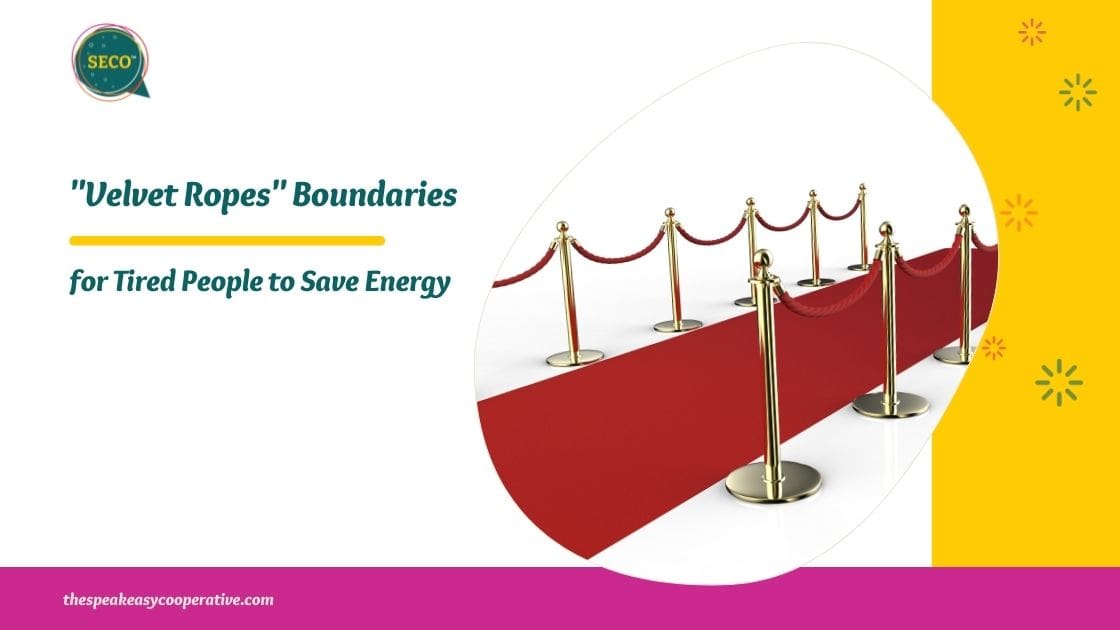Boundaries for Tired People.
I remember thinking about this a year ago, when I did a Facebook live on Boundaries. (Watch it!) We all know It’s one thing to set a boundary; it’s another thing to uphold it. Upholding boundaries can be exhausting – this is why I have a firm commitment to “velvet rope” boundaries. These are boundaries for tired people; people who know what they want and need yet no longer hold the mental space to continually enforce them.
A boundary is a guideline, rule or limit that a person creates to identify for themselves what are reasonable, safe, and permissible ways for other people to behave around them, and how they will respond when someone steps outside of those limits.
I get it – enforcing boundaries comes with lot’s of “I don’t want to be rude” or “I don’t want to hurt someone’s feelings” and “I’ll be the grown up here” type mental gymnastics. Also, let’s face it, it’s super annoying to consistently have to enforce a relatively “easy” boundary.
This is why I like having velvet rope boundaries at my disposal. Mostly because 1. I am tired (I’ll be okay, I just didn’t sleep very well this week) and 2. As I reflect on my own journey with boundaries and guide others through the same, I am always struck with how they change.
And why shouldn’t they? We are humans. People grow. People change. We shift our perspectives and heal. It makes sense that since our boundaries are determined by us and where we are in our emotional lives, that as our emotional lives change, our boundaries will, too.
Boundaries for Tired People – Velvet Ropes
It can be exhausting to enforce a boundary – especially around the holidays, especially when it’s one you’ve stated a million times before, especially if the boundary is outlined in a policy.
When I just don’t have it in me to continually draw a boundary over and over again, I have a little trick – I set up a tool and system to draw the boundary for me. I call this a “Velvet Rope” boundary.
A Velvet Rope boundary is a boundary that’s been set up, everyone gets, but can be easily moved if need be – just like a velvet rope in a (wait for it) speakeasy (HA I KILL ME!).
Side note: Disney’s velvet rope boundary game is ON POINT. Have you ever been to a parade there? Where do they hide all those ropes and poles? They are not there for 90% of the day, then people start gathering, then BOOM ROPES, then the parade is over, and they are GONE! DISNEY MAGIC INDEED.
Velvet Rope boundaries can include an auto responder on an email, turning off notifications on your phone, requiring a paid discovery call, or even autopay.
Automated processes and systems around onboarding and off boarding clients is another example. (I talked about student onboarding recently on The Full Voice Podcast, check it out.)
A personal favorite of mine is a closed office door, established to mean “unless someone’s limb is in a position it should not be in, or there is blood, do not come in. Yes, you can have a snack. Go ask your father.” (See I am the smart one because I am the one with the clear boundary… hubby has yet to take my advice so he is the one who gets bothered all the time. Why am I so brilliant?!)
Having tech tools that do boundary setting for me and the team ensures that we are communicating boundaries consistently and often.
I even create systems asking the question “what does it look like when I need boundaries for tired people?” so that I can set up systems and tools that honor the team’s capacity as much as possible.
These velvet ropes ensure my most valuable resource is protected – my time.
Let’s say you have a person who always pays late. With the right kinds of automations set up, if a payment fails, you don’t need to go chasing down money – the automations will do it for you. A savvy combination of templated and set emails, along with a payment gateway or shopping cart that allows for sending “hey, your credit card is about to expire” notices can save you a world of time and emotional labor.
When to move a Velvet Rope
Again, a Velvet Rope boundary is one that is moveable when necessary. Some times, the kids will be bleeding – door open right away! Sometimes, there are out-of-the-clients control circumstance of the person with the late payments.
Sometimes (DO NOT TELL ANYONE) we even check our email on weekends (GASP!), when we know something important is coming up. This is rare, indeed, yet I hope you get the point – velvet ropes are moveable.
A few rules to follow in order to make your Velvet Rope experience the best it can be:
- Never move a velvet rope if it will cause anger that you are unwilling to process through. If moving it is gonna make you mad, you can move it, but ya gotta work through that shit so it doesn’t take root in bitterness and resentment.
- When you move a velvet rope, communicate which rope you moved and how you moved it, so that it’s clear and understood that the allowance of a boundary move is the exception and not the rule.
- Create velvet ropes to enforce boundaries that you are already used to enforcing and have a clear idea of the boundary needed. If a particular boundary is difficult for you articulate, decide what problem the boundary is actually trying to solve by using a velvet rope. It will be difficult to craft a well working system when you aren’t clear on the boundary in the first place.
- Boundaries for tired people does not mean boundaries for emotionally lazy people. Using velvet ropes as an avoidance tactic rarely works out in the long run. As in, don’t set up autopay because you are terrified to tell people they owe you money.
Boundaries for tired people does not mean boundaries for emotionally lazy people.
MICHELLE MARKWART DEVEAUX
The Art of the Inquiry:
The Secret to Revenue, Relationships, and Retention
Discover each step of the inquiry process and get tangible actions items to implement in your own business right away. GET YOUR COPY HERE.

Some Boundaries are Brick Walls
Not all boundaries are Velvet Ropes – some boundaries are Brick Walls. Immovable, steadfast, protective, and clear.
These boundaries can look like what kind of behavior we allow in front of us. How we are spoken to.
They look like things that protect our mental and physical health, as well as what we find most valuable.
Next week, I’ll explore what a Brick Wall boundary looks like, and how to navigate setting them and enforcing them.
But for THIS week – tell me – what are your “velvet rope” boundaries, and what systems and tools do you have set up to enforce them?







I don’t have a waiting room space for my students, and I get angsty when they knock on my door early. I’m thinking that a velvet rope boundary for me could be… you’re welcome to arrive on the hour (or half hour); please knock so that I know you’re here & ready for a lesson; I’ll open my door when I am ready for you. Something like that? If I want to give 5-10 minutes extra to a student, that needs to be my choice. Lessons are 50-minutes long, and they don’t think about how those extra 10-minutes add up over the course of the semester (to equal 2 additional lessons, for instance). Now, how to communicate all of that w/grace & clarity…
I think that’s a great idea, KimberlyJ! A sign on the door saying just this would be perfect! You can make it even more inviting in the language, while also being clear! How about something like: “I look forward to our session on the hour (or half hour). When you arrive, please knock so that I know you’re here & ready for a lesson. I’ll open the door when I am ready for our magic-making!”
(of course you don’t need to do that, whatever works best for your studio culture, I just offered this since your last sentence seemed to be thinking through language!)